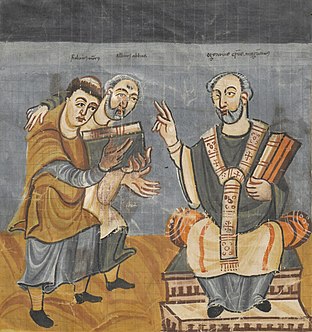This page is based on this
Wikipedia article Text is available under the
CC BY-SA 4.0 license; additional terms may apply.
Images, videos and audio are available under their respective licenses.

Year 856 (DCCCLVI) was a leap year starting on Wednesday of the Julian calendar.

Langres is a commune in northeastern France. It is a subprefecture of the department of Haute-Marne, in the region of Grand Est.

The Lingones were a Celtic tribe that originally lived in Gaul in the area of the headwaters of the Seine and Marne rivers. Some of the Lingones migrated across the Alps and settled near the mouth of the Po River in Cisalpine Gaul of northern Italy around 400 BC. These Lingones were part of a wave of Celtic tribes that included the Boii and Senones. The Lingones may have helped sack Rome in 390 BC.
Theobald is a Germanic dithematic name, composed from the elements theod- "people" and bald "bold". The name arrived in England with the Normans.
Floruit, abbreviated fl., Latin for "he/she flourished", denotes a date or period during which a person was known to have been alive or active. In English, the word may also be used as a noun indicating the time when someone "flourished".

The Roman Catholic Diocese of Langres is a Roman Catholic diocese comprising the département of Haute-Marne in France.

Langres Cathedral is a Roman Catholic church in Langres, France. It was erected in the twelfth century, and is dedicated to the 3rd-century martyr Mammes of Caesarea. The cathedral is the seat of the Bishop of Langres, and is a national monument.

Saint Urban of Langres was a French saint and bishop. He served as the sixth bishop of Langres from 374 until his death. Saint Leodegaria was his sister.
Eardwulf or Eardulf is an Anglo-Saxon male name. Notable people with the name include:

The Roman Catholic Archdiocese of Dijon is a diocese of the Latin Rite of the Roman Catholic Church in France. The archepiscopal see is Dijon Cathedral, which is located in the city of Dijon. The diocese comprises the entire department of Côte-d'Or, in the Region of Bourgogne. Originally established as the Diocese of Dijon in 1731, and suffragan to the Archdiocese of Lyon, the diocese was elevated to the rank of archdiocese in 2002. The most significant jurisdiction change occurred after the Concordat of 1801, when the diocese annexed the department of Haute-Marne. In 1821, a Papal Bull re-established the Diocese of Langres. The current archbishop is Roland Minnerath, appointed in 2004.

Claude de Longwy de Givry (1481–1561) was a French bishop and Cardinal, from an aristocratic background. He was the son of Philippe de Longuy, Seigneur de Givry and Jeanne de Beautremont, Dame de Mirabeau. He had four brothers: Jean de Longuy, Sieur de Givry and Baron de Mirabeau, Christophe de Longuy, Antoine de Longuy, and Étienne de Longuy. Claude's aunt Jeanne had married Guy de la Baume, Count de Montrevel, and one of their sons was Cardinal Pierre de la Baume (1539-1544), Prince and Bishop of Geneva (1522-1543).
Pierre de Pardaillan de Gondrin was the Duke-Bishop of Langres, France.
Léon Aimé Taverde, F.M.C, was a French Prelate of the Roman Catholic Church. Taverde was born in Avanne, France and ordained a priest on 25 September 1955. He was appointed bishop to the Diocese of Langres on 14 October 1981 and ordained bishop on 29 November 1981. He retired on 16 December 1999 as bishop of the Langres Diocese. He died on 8 August 2013.
Oca is a former bishopric in the province of Burgos, Castile and León region, the predecessor of the Roman Catholic Archdiocese of Burgos, and presently a Latin titular see of the Catholic Church. Its Latin adjective is Aucen(sis).
Theutbald II was one of the rival bishops of Langres following the disputed election of 888. According to Flodoard of Reims, he was a relative of Charles the Simple, king of West Francia.
Theobald of Langres was a scholastic teacher and author, probably a lay schoolmaster, although he has also been identified as a Cistercian. He elaborated and expanded on the work of William of Auberive and Geoffrey of Auxerre, crafting a more systematic theory of numerical symbolism. He left behind one treatise on the subject, De quatuor modis quibus significationes numerorum aperiuntur, written in a dry style. It has been edited critically by René Delaflie (1978) and Hanne Lange (1979). A bit of Theobald's advice is:
When you want to sacramentize a number [i.e., "make it mean"], you should unfold the aforesaid ways of sacramentizing, and turn them over in your mind, because in such frequent consideration, you may perhaps find what you are looking for, lying hidden.
The Capitulary of Servais was the implementation of an agreement between Charles the Bald and his half-brother Lothar to maintain the peace. In a conference of Charles and Lothar at Valenciennes in 853, the missi [literally, the sent ones] were re-established after a long hiatus. Lothar recommended that peace and justice be secured by sending out missi to enforce the laws and help keep the peace. The Diet of Servais confirmed the decisions arrived at during the conference. The Capitulary of Servais was enacted by Charles in November 853 dividing the Franco-Burgundian portion of Charles’ realm into twelve districts (missatica) to enforce the measures of this agreement. According to Nelson, the twelve missicati and associated missi were:








